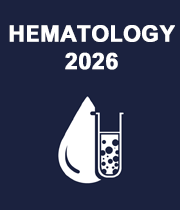Title : Diagnosis and treatment for plasminogen deficiency type 1 (Plgd-1): An ultra-rare hematologic disorder
Abstract:
Plasminogen deficiency (PLGD) is an ultra-rare disorder, which is a subset of rare diseases that affect less than 1,000 individuals in a country. PLGD is classified as hypoplasminogenemia (PLGD-1) or dysplasminogenemia (PLGD-2). PLGD-2 is typically an asymptomatic qualitative disorder resulting from abnormal plasminogen (PLG) activity with a normal PLG antigen. PLGD-1 is a systemic disorder characterized by development of fibrin-rich ligneous lesions on mucus membranes. The estimated prevalence of PLGD-1 is approximately 1.6 per million individuals with approximately 500 symptomatic individuals in the US and 12,000 worldwide. Research shows it takes an average of 7.3 physicians and 4.8 years for a patient to be diagnosed with a rare disease. The rarity of PLGD can make diagnosis challenging due to lack of knowledge and awareness of the disease.
PLGD-1 is an autosomal recessive disorder caused by a homozygous or compound heterozygous mutation on chromosome 6. This results in a deficiency of PLG antigen and PLG activity which causes ligneous, “wood-like”, lesions on mucus membranes throughout the body. The most common manifestations are ligneous conjunctivitis (LC) with an 81% prevalence and ligneous gingivitis (30%). Local infections or injury can trigger lesions to develop, but lesions may also develop spontaneously. Depending on the site, lesions can cause life-threatening conditions, including renal and respiratory failure. Diagnosis for PLGD-1 is confirmed with a PLG antigen and PLG activity level that are both decreased (normal PLG antigen is 6-25 mg/dL and PLG activity is 70-130%).
Treatment options have been limited until the FDA approval of the first plasma-derived human plasminogen, in 2021. This treatment temporarily replaces the missing PLG restoring fibrinolysis.
Audience Takeaway:
- The purpose of this content is to provide education/clinical practice awareness. Due to the ligneous lesions occurring throughout the body, patients may present to a variety of specialties.
- The audience will understand and identify the signs and symptoms of PLGD-1, the laboratory tests used to diagnose, and available treatment.
- Update providers on the recent FDA approval of an orphan treatment for PLGD-1.



